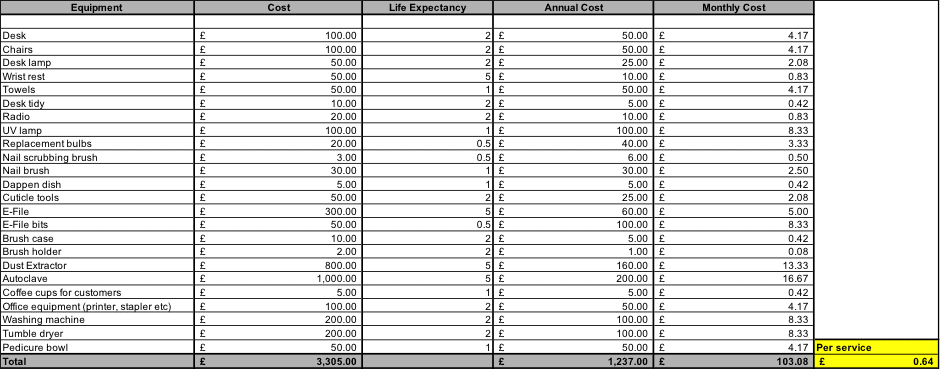
How to work out what you need to charge for nail services in 10 steps
By Katie Barnes | 26 May 2020 | Expert Advice, Feature

Upon the return to work for nail techs, one of the most important considerations along with health & safety is likely to be a pricing for your services.
Many technicians are guilty of looking to their competition when pricing their nail services. When considering your prices; whether setting these from the beginning or looking at an increase, it is important to understand that each and every nail tech and nail business will need to charge completely different prices with many considerations and variables.
Each individual and business model will have both different outgoings and different take-home pay needs. While one tech may be happy to earn minimum wage, another may need £30 per hour to support their household expenditure. If you have a premises, your outgoings will generally be higher than a mobile tech. If you are a mobile nail tech, you would replace your premises fixed costs with travel expenses. If you work from home, you need to take into account a proportion of your household bills.
Outgoings are not just the ‘on desk’ products. Outgoings are composed of running costs, disposables, equipment, products and a take-home wage on top.
To calculate what you should be pricing your nail services at you need to calculate each and every cost to the business.
- Firstly, start with your fixed costs. For items you pay annually, take the annual amount and divide by 12 to get the monthly cost.

- Calculate your depreciable items which include equipment, along with their cost and life expectancy. Take the cost and divide by the life expectancy e.g. one year to get the annual cost. Then take the annual cost and divide by 12 to get the monthly cost.

- Work out your direct costs such as product cost per service. While cost could differ depending on variable factors – such as length of nails e.g. longer nails will require more product, you can calculate the average cost.

- Calculate your disposable costs such as one use items to use alongside your direct costs.

- Don’t forget to include all the additional items that are required to perform nail services that fall into the miscellaneous category. I have added an optional costs category from non-essential but important investments a nail business must make such as training and further education, building maintenance and improvements, servicing equipment and advertising.


- Once you have calculated all of these costs, you then need to determine how many of each treatment you perform each month.

a) Calculate this by the average amount of services you offer per day. Let’s base this example of a full time nail tech working 8.5 hours per day, offering a typical daily column of:
- 1 full set (average 1.5 hours)
- 2 infills (average 1.5 hours)
- 3 gel polish (average 45 mins)
- 1 manicure (average 45 mins)
- 1 pedicure (average 1 hour)
b) Multiply this by how many days you work a day (e.g. 5 days).
c) We need to factor in holidays. Let’s say you take the average 4 weeks per year.
d) Multiply this by how many weeks of the year then work (48).
e) Divide by 12 for the monthly average.
This gives you an average total of services per month of 160.

- Take the total number of services and divide your fixed, depreciable and optional costs by that number.
Fixed costs per month: £1138.33 / 160 = £ 7.11 per service
Depreciable costs per month: £ 98.92 /160 = £0.64 per service
Optional costs per month: £91.68/160 = £0.83 per service
Total costs per month: £8.58.
These costs are incurred to your business whether you are performing services or not.
8. Now add those costs to your direct product and disposable product costs. For each treatment, the costs will remain the same but the only variable will be the direct product cost.
9. Next, you need to add your desired hourly rate onto this.
I have set the example to include National Minimum Wage.

- Subsequently add 20% onto of this wage for Tax and National Insurance contributions.
The total cost per service is your breakeven point. If you set your price at this, you will have 0 profit and no wage above the minimum. Set it below this price and you will be losing money. This is also not taking into consideration pensions; bonuses or any unexpected costs the business may occur.
These calculations are based on a full diary; which is not always the case. You also need to factor the hours you are not earning into these calculations if you are not fully booked.
The final element to consider is whether your nail service prices are realistic and competitive. If not, or you do not want to charge this, then to decrease your total price you need to:
- lower your direct costs or fixed costs
- make sure you reduce wastage
- reduce your timings
- attract more clients to spread out your fixed costs further
- concentrate on services that have the best profit margin
When your costs keep increasing, and your prices don’t rise in line, it is your take-home pay that starts to reduce. Household expenses also continue to increase annually with inflation, so our wage also needs to continue to rise in line with this. Each year, wages increase with annual inflation and living costs and our industry should be no different.
Take the time to ensure you are charging your worth and thriving in your career.
Love Katie B x

Read the latest issue








